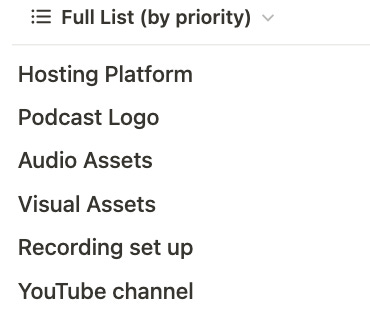Hi, It’s George from Orama, a virtual podcast and video studio for brands.
You can watch this episode on the Substack player, on YouTube, listen to it on podcast platforms, or read an edited transcript below.
I’m testing the video feature of Substack; it’s pretty cool that you only need to upload the video, and it will create an RSS feed from the audio for your podcasts.
How do you transition from Minimum Viable Podcast (something we discussed here before) to Most Valuable Podcast?
As a Frenchman who enjoys watching basketball, I enjoy following the NBA career of Wemby or Victor Wembayama🇫🇷. He’s a newcomer to the NBA, a rookie with a chance to become an MVP.
**Trivia: Only two players in NBA history have done it before: Wes Unseld and Wilt Chamberlain.**
You may be the Wemby of podcasting, in which case congratulations, go for it. But for the rest of us, the great news is that you can gradually elevate to “Most Valuable Podcast” level by improving episode by episode.
If your focus is a brand or niche podcast, the aim is not to top the charts but rather to become the reference point within your industry and a favourite among the small group of people who matter to you.
Shifting the MVP metaphor from NBA to Startups
Let's move to a startup metaphor, where MVP stands for Minimum Viable Product. An MVP approach involves iterating and improving over time. And that’s the idea behind the Minimum Viable Podcast.
If you’re running a company podcast, it might be just a small part of your duties, but the mindset remains akin to a startup transitioning from MVP to something greater. In all humility, creating a defining podcast for a niche is the goal, with my recently relaunched ‘Investology’ podcast, that focuses on investment management (YouTube, Audio podcasts).
The process, not the topic, matters here.
(It’s also the goal with this podcast, but that’s a more remote possibility, as I’m still very close to the Minimum Viable state, so I use Investology as a better example).
Although it's an established podcast, my interest changed from broad fintech to investment management, so I paused it, rebranded, and relaunched it, so it feels brand new.
Below, I'll share the tool I use to manage my own and my clients’ podcasts and how it can help your show as well.
From List to Dashboard
Previously, I used a comprehensive brand podcast checklist for launching and growing podcasts. There are 45 items there (but the list is flexible)
You can access it here.
Even if I’ve launched quite a few podcasts before for Investology, I wanted to do many things at once and… I wasn’t doing much because it felt overwhelming.
Leading me to develop a production dashboard (or development dashboard - I thought this was a better name after the recording)
NB: This is not the usual “performance dashboard” where you can see your past audience stats; this one is forward-looking and qualitative.
Introducing the podcast development dashboard
You can view the Investology version of the dashboard in its current live state here.
Categories
It is organized across four categories: setup and branding, production, distribution, and monetization.
Setup & branding: This is what you need at channel level. It's similar to your brand editorial guidelines.
Production: what you need to create every episode, but also in general what you need to create content from your podcast, and that goes beyond the episodes (think articles, clips, etc.)
Distribution: everything that you need to [00:04:00] grow your podcast
Monetization: is how you generate revenues. But that might sound a bit restrictive because maybe that's not your goal. If you're a brand, you are not planning to generate money directly by monetizing the podcast, but you want to generate value from it. For example, if you manage to promote your services through the podcast, that's useful. If you network with guests, that's also something very valuable. So I'm putting everything in there.
Completion or Progress level
You can visualize them as little gauges, but it could also be a number from 0 to 100, 100 being this is fully done. For example, I haven’t started on a podcast website.
I prefer this gauge over a checklist because nothing is set in stone.
For example, the podcast logo is something that I'm probably not going to change for a long time.
Other elements are more fluid, like setting up a YouTube channel, which is something that I can initiate in a very basic way and improve over time because there's a lot you can do specifically on the YouTube channel in terms of SEO, or graphics.
Setting Priorities
The next aspect is to have a priority view because you shouldn’t always be starting with the thing that's least completed.
For example, you cannot launch a podcast without a hosting platform and a logo. Again, the YouTube channel is an intermediary priority. You don't need to start with that.
Creating Actionable Items
The goal of the dashboard is to create actionable items, and we do this by mixing up the priority with the completion level (via a basic formula in Notion).
So if I look at Setup & Branding: I want to create a trailer. I want to review the audio assets, the music that I use for different tracks. I want to create series that are more distinctive. I want to improve the run of the show.
I can also use it for new ideas. For example, I just thought about having a media kit for sponsors. I haven't got one, so I will put it here in monetization, with a low priority.
The bottom line is that it gives me an overview of what I need to do. It's not overwhelming. It's actionable and itemized.
As a bonus, this can also be used as a reporting tool if you manage a podcast. You can combine it with hard viewership numbers to explain how the show evolves qualitatively and quantitatively.
I hope this dashboard is beneficial for you. Even if you don’t use the file, you may keep the idea.
Here is the link again to the Investology development dashboard.
I'm planning to create a template that I can share in the next newsletter. Stay tuned!
I will be sharing the evolution of the podcast and the template itself.















Share this post